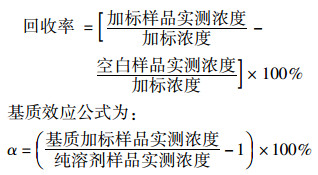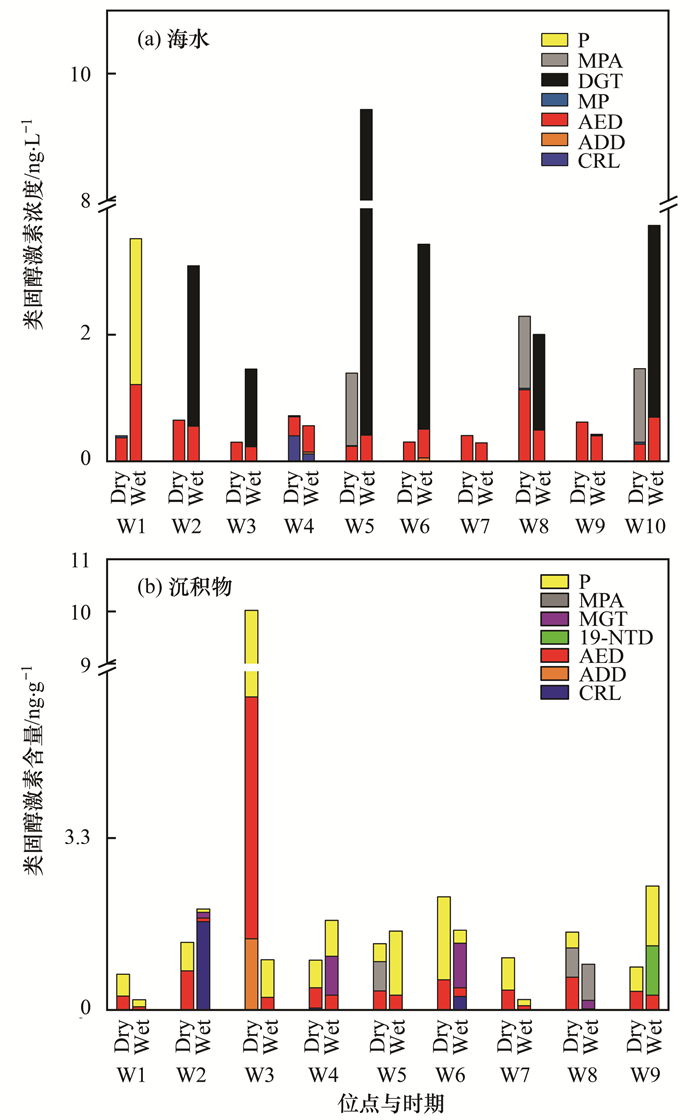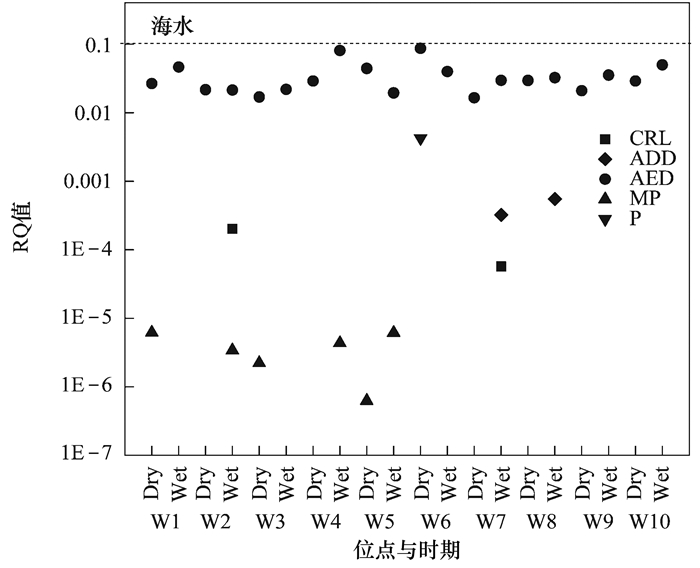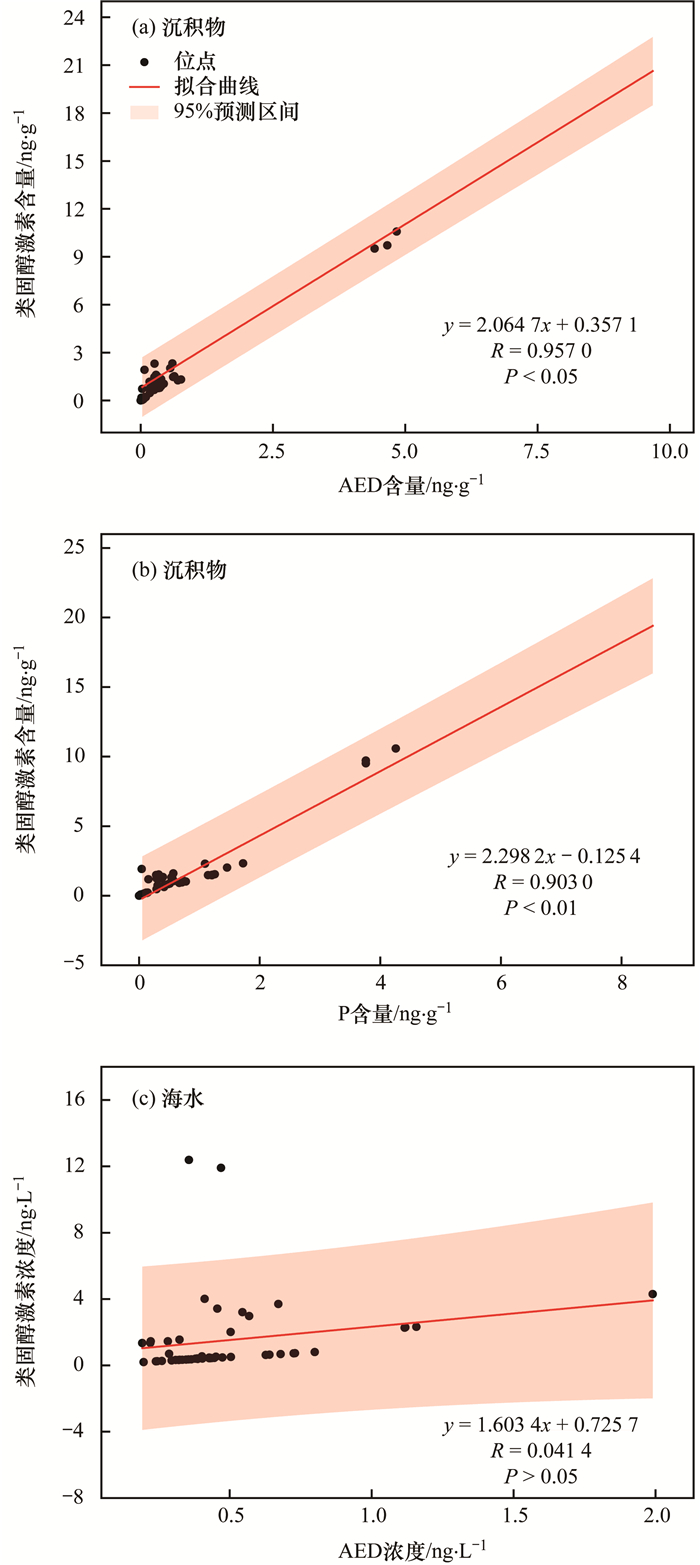2. 华南师范大学环境研究院, 广东省化学品污染与环境安全重点实验室, 广州 510006;
3. 中国科学院大学, 北京 100049;
4. 生态环境部华南环境科学研究所, 广州 510535
2. Guangdong Provincial Key Laboratory of Chemical Pollution and Environmental Safety, Environmental Research Institute, South China Normal University, Guangzhou 510006, China;
3. University of Chinese Academy of Sciences, Beijing 100049, China;
4. South China Institute of Environmental Sciences, Ministry of Ecology and Environment, Guangzhou 510535, China
类固醇激素是一类四环脂肪烃化合物, 具有生物活性基团, 包含环戊烷多氢菲母核, 即三个六元环和一个五元环[1].类固醇激素广泛应用于人类和兽医疗法, 除用于避孕和人类治疗外, 也作为饲料添加剂治疗牲畜疾病和促进动物生长[2~4].全球范围内, 每年进入到环境中的雌激素约为31 t[5], 而中国养猪场和养牛场每年的类固醇激素总贡献量分别高达14 066 t和61 t[6].由于现有污水处理系统不能完全去除类固醇激素, 使得类固醇激素及其代谢产物在环境中蓄积, 给生态环境造成了巨大的压力[7, 8].已有研究表明, 污水处理厂、畜牧场和水产养殖场是环境中类固醇激素的主要来源[6, 8, 9].类固醇激素在污水处理厂、养殖场及其受纳水体中的检出浓度为纳克每升到微克每升[6, 8, 10~13].环境中的类固醇激素是一类非常重要的内分泌干扰物(endocrine disrupting chemicals, EDCs), 其在极低的浓度下(如1 ng ·L-1)就可以影响水生生物的生殖能力和性别比例[14, 15].因此, 环境中残留的类固醇激素可能对人体健康和生态环境产生潜在威胁, 应引起人们的关注.
鉴于海洋环境对社会经济发展的价值及其对污染物的扩散运输作用, 近年来人们对海洋生态环境的保护意识逐步提高.近几十年, 中国水产养殖业快速发展, 已成为全球最大水产养殖国. 2018年, 中国海洋养殖水产品产量为2 000.70万t, 占世界海洋养殖总产量的60.23%[16].网箱和大型高桩围栏等是常见的海产养殖模式.人们在养殖过程中滥用水产养殖药物且缺乏污水处理设施, 加上陆地排放的废水汇入, 导致类固醇激素在水体和海产品中富集.目前, 关于类固醇激素的研究主要集中在淡水环境中的污染特征, 其在海洋环境中的研究则相对较少, 主要原因是海洋环境样品的采集和检测十分困难.在国内, 海洋环境中类固醇激素的污染特征主要是基于Liu等[3, 9, 17, 18]开展的研究.据报道, 在中国畜牧场和海水养殖场中已检出国家质量监督检验检疫总局[19]严禁使用的多种合成类固醇激素, 例如甲基睾酮(MT)、17α-群勃龙(17α-TBL)和17β-群勃龙(17β-TBL)等[3, 6].在欧洲, 欧盟水框架指令要求对沿海地区进行大量监测, 但是优先污染物清单中只包括了雌二醇和乙炔雌二醇两种雌激素, 其他类固醇激素(如:雄激素、孕激素和糖皮质激素等)则少有人关注.
随着中国经济的快速发展, 近海水域环境污染问题也日益严重.流沙湾, 位于广东省雷州半岛西南部, 呈葫芦形的半封闭海湾, 面积约为69 km2, 是中国海水珍珠“南珠”的主产区、广东省重要的贝类养殖区和旅游胜地, 拥有近千亩的海草场.作为一个半封闭的海湾, 流沙湾接受了大量城市生活污水、工业废水和入海河流所携带的大量污染物; 同时, 高密度的虾贝类和鱼类养殖, 导致海湾环境恶化, 有机物污染严重[20].本研究以流沙湾为研究对象, 调查了海水和沉积物中33种类固醇激素的含量水平, 探讨了类固醇激素的时空变化规律, 采用风险商法对水体类固醇激素进行了生态风险评价, 探索了雄烯二酮(AED)和黄体酮(P)作为类固醇激素化学指示剂的可能性, 以期为后续流沙湾的生态环境防护提供科学依据.
1 材料与方法 1.1 化学物质和样品采集33种高纯度的天然和合成类固醇激素标品, 包括11种雄激素、17种孕激素、5种糖皮质激素和7种内标, 详情见表 1.
|
|
表 1 类固醇激素及其内标物基本信息和UPLC MS/MS参数1) Table 1 Basic information and UPLC MS/MS parameters for steroid hormones and internal standards |
以枯水期和丰水期的流沙湾为研究对象, 分别于2017年11月(枯水期)和2018年8月(丰水期)在流沙湾湾内(W1~W6, W9)、湾外(W7)和岸边养殖池塘(W8和W10)采样, 其中, W10点处于岸边规模化养殖虾塘, 覆盖虾塘防渗膜, 无沉积物. 10个采样点(图 1)详细信息见于表 2.水样在0~100 cm的深度重复多次采集, 设置3个平行, 每个样品体积为1 L, 现场加入50 mL甲醇和400 μL 4 mol ·L-1的硫酸, 调节pH到3.采用不锈钢抓斗采泥器收集0~30 cm的表层沉积物, 加入适量叠氮化钠, 用于抑制微生物对目标物的降解.所有采集的样品立即放入保温箱, 保持4℃低温, 运回实验室, 48 h内完成前处理.固体样品经冻干、研磨后过60目筛, 放入4℃冷库中保存待处理.

|
图 1 流沙湾采样点位分布示意 Fig. 1 Study area and sampling sites in the Liusha Bay |
|
|
表 2 流沙湾采样点水质参数1) Table 2 Information of water quality parameters for the sampling sites in Liushawan Bay |
1.2 样品提取与仪器分析
样品提取和仪器分析条件参考Liu等[18, 21]的研究.简而言之, 每份水样(1 L)用玻璃纤维滤膜过滤(Whatman GF/F, 0.7 μm UK), 加入1 mg ·L-1内标100 μL, 然后用HLB柱(500 mg, 6 mL)进行固相萃取, 采用10 mL甲醇(3、3和4 mL)和10 mL乙酸乙酯(3、3和4 mL)依次洗脱.提取液于室温下缓慢地氮气吹干后定容于1 mL的默克甲醇, 经过0.22 μm的有机相针式滤膜过滤, 保存于2 mL的棕色小瓶待测.对于沉积物样品, 称取2 g于30 mL玻璃离心管中, 加入1 mg ·L-1内标100 μL, 置于4℃冷库过夜, 分别采用10、10和5 mL乙酸乙酯:甲醇(8 :2)超声萃取沉积物15 min, 以3 500 r ·min-1离心10 min, 将上清液转移至300 mL梨形瓶中, 45℃条件下旋转蒸发完全, 重新溶于2 mL默克甲醇, 加水稀释至250 mL, 加入30 μL 4 mol ·L-1 H2SO4, 采用HLB柱(200 mg, 6 mL)进行固相萃取, 然后用乙酸乙酯:甲醇(9 :1)混合液4 mL洗脱3次, 提取液吹干后重新定容于1 mL的默克甲醇, 经过0.22 μm的有机相针式滤膜过滤, 保存于2 mL的棕色小瓶待测.
流动相:A瓶为5 mmol ·L-1乙酸铵和0.05%甲酸, B瓶为默克甲醇, 流速为0.35 mL ·min-1; 进样体积为10 μL; 柱温40℃.梯度洗脱程序:0~10 min, 40%~33%A; 10~15 min, 33%~25%A; 15~16 min, 20%~10%A; 16~24 min, 10% A, 24~30 min, 10%~40%A.电离源为电喷雾离子源正离子模(ESI+), 干燥气(氮气)流速为6 L ·min-1, 温度为280℃; 雾化气(氮气)压力为50 psi; 鞘气(氮气)流速为12 L ·min-1, 温度为350℃; 毛细管电压为2 500 V.各目标物和内标的UPLC-MS/MS(Agilent 1290 Infinity Ⅱ高效液相色谱仪-Agilent 6495三重四极杆质谱仪)检测参数如表 1所示.
1.3 定量方法及回收率所有的化学分析都实行严格的质量保证和质量控制体系.加标回收率实验, 采用内标法, 将33种类固醇和7种内标加入背景海水和沉积物样品, 即在1 L过滤海水和2 g干净的冻干沉淀物用相同的方法加入目标化合物和同位素标记物, 同时通过检测空白样品, 计算加标回收率、基质效应、检出限和定量限, 以衡量方法的可靠性.
在海水(ng ·L-1)和沉积物(ng ·g-1)中分别进行3个不同含量(10、50和100)的加标实验, 回收率计算公式如下:

|
对海水和沉积物进行低浓度加标提取, 计算信噪比, 用该浓度除以信噪比, 其结果的3倍为该方法的检出限(method detection limit, MDL), 10倍为定量限(method quantification limit, MQL).
1.4 生态风险评价方法根据欧盟的环境生态风险评价方法, 本文选择风险商(risk quotient, RQ)法评估水生环境的生态风险水平[22].

|
式中, MEC(measured environmental concentration)为污染物实际测试浓度; PEC(predicted environmental concentration)为污染物环境预测浓度; PNEC(predicted no effect concentration)为预测无效应浓度. PENC等于毒性数据[LC50/NOEC(median lethal concentration/no observed effect concerntration)或LE50/NOEC(life expectancy at age 50/no observed effect concerntration)]与评估因子(assessment factor, AF)的比值.当采用急性毒性L(E)C50数据时, AF取值1 000;当采用慢性毒性NOEC数据时, AF取100. RQ用于表征生态环境风险程度, RQ值越高, 表明污染物对水环境中的生物风险越高.其中, 0.01~0.1, 低风险; 0.1~1, 中等风险; >1, 高风险[18].
1.5 数据分析采用R x64 3.5.2进行相关性分析, ArcGIS 10.5和OriginLab 2018进行图形绘制.
2 结果与讨论 2.1 方法验证背景海水(ng ·L-1)和沉积物(ng ·g-1)中的加标含量分别为10、50和100, 使用UPLC-MS/MS分析样品中的33种类固醇激素的回收率、基质效应、检出限和定量限如表 3所示.海水检出限和定量限分别为0.009~1.354 ng ·L-1和0.029~4.152 ng ·L-1,沉积物检出限和定量限分别为0.087~3.107 ng ·g-1和0.290~10.358 ng ·g-1.大部分类固醇激素的回收率均在可接受范围内.总体来说, 该方法可基本满足海水和沉积物中33种类固醇激素的提取和检测.
|
|
表 3 UPLC-MS/MS分析海水和沉积物中类固醇激素的回收率、基质效应、检出限和定量限1) Table 3 Recovery, matrix effects, method of detection, and quantification limits for steroid hormones in seawater and sediment by UPLC-MS/MS |
2.2 海水和沉积物中类固醇激素的含量分布
流沙湾海水和沉积物中33种类固醇激素的污染分布特征如图 2所示.海水中共检出7种类固醇激素:CRL、ADD、AED、MP、DGT、MPA和P, 除DGT外(浓度最高达9.023 ng ·L-1), 整体检出浓度均低于1.214 ng ·L-1, 这与吴世闽等[23]在辽东湾检出的雌激素和Liu等[18]在海陵湾检出的雄激素、孕激素和糖皮质激素浓度处于同一数量级.其中, AED的检出率达100%, 浓度范围为0.231~1.214ng·L-1. MP和MPA仅在枯水期检出, 浓度范围为ND~1.162 ng ·L-1. ADD和DGT仅在丰水期检出, 浓度范围为ND~9.023 ng ·L-1, 而CRL和P仅在个别采样点有检出, 最高浓度达2.306 ng ·L-1.对比海水样品中7种类固醇激素的平均浓度, 合成类固醇激素DGT和MPA远高于4种天然类固醇激素(CRL、ADD、AED和P)和合成类固醇激素(MP), 说明流沙湾地区可能存在滥用类固醇激素药物的现象.

|
Dry:枯水期; Wet:丰水期 图 2 流沙湾海水和沉积物中33种类固醇激素的时空分布 Fig. 2 Temporal and spatial distribution of 33 steroid hormones in seawater and sediments of Liusha Bay |
在沉积物中共检出7种类固醇激素:CRL、ADD、AED、19-NTD、MGT、MPA和P, 除枯水期W3采样点外(含量最高达4.641 ng ·g-1), 整体含量均较低.其中, AED和P的检出率分别达100%和94%, 含量范围分别为0.025~4.641 ng ·g-1和ND~4.011 ng ·g-1.其他类固醇激素的检出率均低于22%, 含量范围为0.009~1.695 ng ·g-1. 19-NTD仅在丰水期W9采样点检出, 含量为0.947 ng ·g-1, 19-NTD主要与炔雌醇合用, 作为短效口服避孕药经常被人们使用, 该点检出的原因可能是附近村庄生活污水未经处理直接排放导致.尽管沉积物中类固醇激素的含量较低, 由于类固醇激素, 尤其是合成类固醇激素具有难降解性[26], 可能使沉积物成为类固醇激素的潜在源汇.有研究发现, 鱼类和沉积物直接接触导致类固醇激素成为生物活性物质, 对生物产生危害, 应进一步研究沉积物中类固醇激素对水生生物的毒理效应机制[17].
比较海水中7种类固醇激素的时间分布可知(图 2), 整体上丰水期高于枯水期, 主要是因为DGT的贡献率较高, 平均检出浓度为2.985 ng ·L-1, DGT常用于治疗痛经和子宫内膜异位症, 因具有不影响排卵和人体体温等优点被广泛使用[24].导致上述结果的原因可能是丰水期的大量降雨形成地表径流携带生活污水汇入湾内.在未检出DGT的W4, W7和W9采样点中, 总类固醇激素浓度差异较小, 低于1 ng ·L-1.在沉积物中, 枯、丰水期整体检出含量差异较小, 整体低于2.380 ng ·g-1.枯水期的W3采样点除外(该点含量达到10.020 ng ·g-1), 这可能是因为W3采样点处于湾内靠岸区, 有地表径流携带富含类固醇激素的泥沙流入湾内, 导致该点总体类固醇激素含量升高.
2.3 类固醇激素的空间分布类固醇激素在10个采样点的空间分布如图 2所示.在枯水期所有水样中, 类固醇激素总浓度趋势为养殖区(W5、W8和W10)>湾内(W1-W4、W9)、湾口(W6)和湾外(W10), 主要原因是在养殖区检出了合成类固醇激素MPA, 浓度范围为1.140~1.161 ng ·L-1, 表明人类活动造成了养殖区类固醇激素污染.在丰水期的所有水样中, 养殖区(W5、W8和W10)和湾口(W6)高于绝大部分非养殖区, 主要是因为养殖区和湾口检出了合成类固醇激素DGT(1.511~9.023 ng ·L-1).有研究表明, 环境中的DGT在浓度低至3.39 ng ·L-1条件下就可造成斑马鱼雄性化且加快精子成熟, 对鱼群构成潜在的高生态风险, 应引起人们的高度关注[25].类固醇激素浓度分布在空间上的差异, 可能是因为丰水期(8月)是虾蟹扇贝幼苗投放的主要时期, 饲料中常添加多种类固醇激素, 甚至检出了我国明确禁止使用的激素17β-TBL[9], 这表明在海水养殖中类固醇激素被非法使用, 水产养殖是类固醇激素污染的重要来源之一.在沉积物中, 除枯水期W3点外, 枯、丰水期的其他采样点总类固醇激素含量无明显差异, 这可能是7种类固醇激素的理化性质导致的(lg Koc: 1.38~3.51), 更倾向于在水中富集[18].
2.4 类固醇激素与常规指标的相关性分析类固醇激素进入环境后, 会发生吸附、水解、光解和生物降解等环境行为[26], 同时其分布还受pH、溶解氧和盐度等理化指标的影响.由图 3可知, 在枯水期水样中, 盐度和水温与AED、MP和MPA呈负相关, 这可能是因为盐度影响类固醇激素的溶解度, 导致其吸附在颗粒物上[27]; 温度也是显著影响类固醇激素吸附的重要原因[28].悬浮物(particulate matter, SS)与MP呈显著正相关, 这可能与物质的理化性质有关[8].在丰水期的水样中, AED与化学需氧量(chemical oxygen demand, COD)和P呈显著正相关, 这与Liu等[18]研究结果一致, 其发现南海海陵湾类固醇激素浓度与COD和NH4+-N的浓度具有显著相关性.总体上, 类固醇激素与溶解氧(dissolved oxygen, DO)、pH和COD等都有一定的相关性, 说明类固醇激素在水环境中的浓度水平受到了环境因素的影响.

|
图 3 类固醇激素浓度与常规指标的相关性分析 Fig. 3 Correlation between steroid hormone concentrations and traditional water quality index |
环境中的类固醇激素可能对生物构成潜在的风险, 以往的研究更多集中在水生环境中雌激素的风险评估[23, 29].根据欧盟委员会技术指导文件, 采用RQ方法来初步进行风险评估, 使用半数效应浓度(EC50)或化学品的NOEC值来计算出PNEC值[22].目前, 关于雌激素的水生毒性数据已经很多, 例如, 17β-雌二醇的PNEC为1.5 ng ·L-1.然而, 对于其他类固醇, 特别是雄激素、孕激素和糖皮质激素, 水生毒性数据仍然有限或者是空白的.通过查阅相关文献, 使用评估因子方法计算出6种类固醇激素的PNEC值见表 4[18, 30].
由图 4可知, 枯、丰水期水样中AED的RQ值为0.016 52~0.086 69, 显示低风险.水样中其他物质的RQ值均低于0.01, 显示无风险.总之, 相比于污水处理厂、养殖场及其受纳河流中数百至数千ng ·L-1的检出浓度[6~8], 流沙湾地区受类固醇激素的污染相对较轻.值得注意的是, 由于类固醇激素, 特别是合成类固醇激素毒性数据的缺乏, 影响PNEC值的准确性, 导致上述风险评估存在一定局限性.同时, 目前的风险评估仅针对自由态类固醇激素, 未考虑共轭态类固醇激素, 这可能会低估环境中类固醇激素对环境构成的生态风险.后续应进一步加强共轭态类固醇激素的风险评估研究.

|
Dry, 枯水期; Wet, 丰水期 图 4 流沙湾水体类固醇激素RQ值 Fig. 4 RQ values for steroid hormones in Liusha Bay |
污水指示剂可以指示水体是否受到污水影响以及水体受污水影响的程度, 近年来受到了人们的广泛关注[7, 18].理想的化学指示剂应在受纳水体中广泛检出, 检出率大于80%, 且是亲水性物质[31].在本研究中, 仅AED和P的检出率超过80%, 数据集的回归分析表明(图 5), 沉积物中AED和P的浓度与沉积物中类固醇激素总浓度之间均有良好的正线性相关性(P < 0.05).在水样中, 因P的检出率低于80%, 仅在W1采样点水样中检出, 因此本研究只做水中AED和水中类固醇激素总浓度之间的相关性分析, 结果表明二者之间的相关性较差(P>0.05), AED不能作为流沙湾地区类固醇激素的化学指示剂.之前的研究结果表明[7, 18], P可以作为海水和淡水中类固醇激素的优良指示剂.与上述结果存在差异的原因可能是采样点数量有限, 且包括了岸边养殖塘采样点, 导致水样中检出合成类固醇激素(如MP和MPA), 进而影响了AED与其他类固醇激素和类固醇激素总浓度之间的相关性.

|
图 5 化学指示剂与水和沉积物中每个位点的类固醇激素总含量之间的相关性 Fig. 5 Correlation analysis between the chemical indicator concentrations and the total concentrations of steroid hormones at each site in both water and sediment |
尽管数据有限, AED和P均不能作为流沙湾地区类固醇激素的优良化学指示剂, 但是本研究依旧为流沙湾地区类固醇激素的污染特征及其归趋提供了有价值的信息, 为预防及治理流沙湾地区类固醇激素污染提供了科学依据.应进一步加强研究, 提供更全面的数据, 重新评估AED和P是否可作为环境水体中类固醇激素可靠的化学指示剂.
3 结论(1) 本研究优化了UPLC-MS/MS同时测定33种类固醇激素的方法, 方法整体检出限和定量限较低, 加标回收率良好, 满足水样和沉积物中类固醇激素的痕量分析.
(2) 33种类固醇激素中共有9种检出, 检出频率由高到低为AED>P>其他, 整体上表现出合成类固醇激素高于天然类固醇激素, 丰水期高于枯水期, 主要是由水产养殖人为饲料添加和废水排放造成.
(3) 相关性分析表明, 类固醇激素在海洋环境中的浓度分布规律与盐度、水温、SS和COD有关, 其含量水平受到环境因素的制约和影响.
(4) 类固醇激素的生态环境风险整体处于低等风险或无风险, 但多种类固醇激素的存在可能会对水生生物和人体健康构成风险, 应给予关注.
(5) 综上所述, 流沙湾水体和沉积物中类固醇激素的污染程度相对较轻, 但随着当地经济和人口的快速发展, 水产养殖规模不断扩大, 类固醇激素不断由陆地地表径流和人为饲料添加等方式输入水体, 对环境构成潜在风险.因此, 有必要加强类固醇激素的毒理研究, 尤其是关于共轭态类固醇激素的研究, 得出更精确的PNEC值, 更加合理评估类固醇激素的环境风险.同时, 需要更多的数据来重新评估AED和P作为流沙湾地区类固醇激素化学指示剂的可靠性.
致谢: 感谢华南环境研究所陈清华和孙凯峰提供流沙湾海水水质参数.钟超、刘伟杰、蔡稳稳和熊倩等在采样和实验方面提供帮助, 在此一并致谢!| [1] | Streck G. Chemical and biological analysis of estrogenic, progestagenic and androgenic steroids in the environment[J]. TrAC Trends in Analytical Chemistry, 2009, 28(6): 635-652. DOI:10.1016/j.trac.2009.03.006 |
| [2] | Liu S, Ying G G, Zhou L J, et al. Steroids in a typical swine farm and their release into the environment[J]. Water Research, 2012, 46(12): 3754-3768. DOI:10.1016/j.watres.2012.04.006 |
| [3] | Liu S, Chen H, Xu X R, et al. Steroids in marine aquaculture farms surrounding Hailing Island, South China:occurrence, bioconcentration, and human dietary exposure[J]. Science of the Total Environment, 2015, 502: 400-407. DOI:10.1016/j.scitotenv.2014.09.039 |
| [4] | Lange I G, Daxenberger A, Schiffer B, et al. Sex hormones originating from different livestock production systems:fate and potential disrupting activity in the environment[J]. Analytica Chimica Acta, 2002, 473(1-2): 27-37. DOI:10.1016/S0003-2670(02)00748-1 |
| [5] | Adeel M, Song X M, Wang Y Y, et al. Environmental impact of estrogens on human, animal and plant life:a critical review[J]. Environment International, 2017, 99: 107-119. DOI:10.1016/j.envint.2016.12.010 |
| [6] | Liu S, Ying G G, Zhang R Q, et al. Fate and occurrence of steroids in swine and dairy cattle farms with different farming scales and wastes disposal systems[J]. Environmental Pollution, 2012, 170: 190-201. DOI:10.1016/j.envpol.2012.07.016 |
| [7] | Chang H, Wan Y, Hu J Y. Determination and source apportionment of five classes of steroid hormones in urban rivers[J]. Environmental Science & Technology, 2009, 43(20): 7691-7698. |
| [8] | Liu S, Ying G G, Zhao J L, et al. Occurrence and fate of androgens, estrogens, glucocorticoids and progestagens in two different types of municipal wastewater treatment plants[J]. Journal of Environmental Monitoring, 2012, 14(2): 482-491. DOI:10.1039/C1EM10783F |
| [9] | Liu S, Chen H, Xu X R, et al. Three classes of steroids in typical freshwater aquaculture farms:comparison to marine aquaculture farms[J]. Science of the Total Environment, 2017, 609: 942-950. DOI:10.1016/j.scitotenv.2017.07.207 |
| [10] | Sim W J, Lee J W, Shin S K, et al. Assessment of fates of estrogens in wastewater and sludge from various types of wastewater treatment plants[J]. Chemosphere, 2011, 82(10): 1448-1453. DOI:10.1016/j.chemosphere.2010.11.045 |
| [11] | Fan Z L, Wu S M, Chang H, et al. Behaviors of glucocorticoids, androgens and progestogens in a municipal sewage treatment plant:comparison to estrogens[J]. Environmental Science & Technology, 2011, 45(7): 2725-2733. |
| [12] | Zheng W, Yates S R, Bradford S A. Analysis of steroid hormones in a typical dairy waste disposal system[J]. Environmental Science & Technology, 2008, 42(2): 530-535. |
| [13] | Liu S S, Ying G G, Liu Y S, et al. Occurrence and removal of progestagens in two representative swine farms:effectiveness of lagoon and digester treatment[J]. Water Research, 2015, 77: 146-154. DOI:10.1016/j.watres.2015.03.022 |
| [14] | Fick J, Lindberg R H, Parkkonen J, et al. Therapeutic levels of levonorgestrel detected in blood plasma of fish:results from screening rainbow trout exposed to treated sewage effluents[J]. Environmental Science & Technology, 2010, 44(7): 2661-2666. |
| [15] | Huang B, Wang B, Ren D, et al. Occurrence, removal and bioaccumulation of steroid estrogens in Dianchi Lake catchment, China[J]. Environment International, 2013, 59: 262-273. DOI:10.1016/j.envint.2013.06.018 |
| [16] | 国家海洋局. 2018中国渔业统计年鉴[EB/OL]. http://www.fishfirst.cn/article-106894-1.html. |
| [17] | Liu S, Xu X R, Qi Z H, et al. Steroid bioaccumulation profiles in typical freshwater aquaculture environments of South China and their human health risks via fish consumption[J]. Environmental Pollution, 2017, 228: 72-81. DOI:10.1016/j.envpol.2017.05.031 |
| [18] | Liu S, Chen H, Zhou G J, et al. Occurrence, source analysis and risk assessment of androgens, glucocorticoids and progestagens in the Hailing Bay region, South China Sea[J]. Science of the Total Environment, 2015, 536: 99-107. DOI:10.1016/j.scitotenv.2015.07.028 |
| [19] | 国家质量监督检验检疫总局.动物性食品中兽药最高残留限量(农业部2002年235号公告)[EB/OL]. http://jckspaqj.aqsiq.gov.cn/dwyxspjyjy/gnxgbz/200610/t20061027_9809.htm. |
| [20] |
郭永坚, 罗昭林, 李俊伟, 等. 2012-2013年流沙湾海水养殖区水环境质量评价[J]. 广东农业科学, 2015, 42(19): 130-136. Guo Y J, Luo Z L, Li J W, et al. Assessment of water environmental quality of mariculture areas in Liusha Bay in 2012-2013[J]. Guangdong Agricultural Sciences, 2015, 42(19): 130-136. DOI:10.3969/j.issn.1004-874X.2015.19.021 |
| [21] | Liu S, Ying G G, Zhao J L, et al. Trace analysis of 28 steroids in surface water, wastewater and sludge samples by rapid resolution liquid chromatography-electrospray ionization tandem mass spectrometry[J]. Journal of Chromatography A, 2011, 1218(10): 1367-1378. DOI:10.1016/j.chroma.2011.01.014 |
| [22] |
赵建亮, 应光国, 魏东斌, 等. 水体和沉积物中毒害污染物的生态风险评价方法体系研究进展[J]. 生态毒理学报, 2011, 6(6): 577-588. Zhao J L, Ying GG, Wei D B, et al. Ecological risk assessment methodology of toxic pollutants in surfacewater and sediments:Areview[J]. Asian Journal of Ecotoxicology, 2011, 6(6): 577-588. |
| [23] |
吴世闽, 贾瑷, 彭辉, 等. 辽东湾海水中甾体雌激素的检测及生态风险评价[J]. 中国环境科学, 2011, 31(11): 1904-1909. Wu S M, Jia Y, Peng H, et al. Determination and risk assessment of steroidal estrogens in Liaodong Bay, China[J]. China Environmental Science, 2011, 31(11): 1904-1909. |
| [24] | Taniguchi F, Ota I, Iba Y, et al. The efficacy and safety of dydrogesterone for treatment of dysmenorrhea:an open-label multicenter clinical study[J]. Journal of Obstetrics and Gynaecology Research, 2019, 45(1): 168-175. DOI:10.1111/jog.13807 |
| [25] | Shi W J, Jiang Y X, Huang G Y, et al. Dydrogesterone causes male bias and accelerates sperm maturation in zebrafish (Danio rerio)[J]. Environmental Science & Technology, 2018, 52(15): 8903-8911. |
| [26] |
刘珊.城市污水处理厂和畜牧养殖环境中类固醇激素物质的污染特征与环境行为研究[D].广州: 中国科学院广州地球化学研究所, 2013. Liu S. Occurrence and fate of steroids in waste water treatment plants and livestock farms in China[D]. Guangzhou: Guangzhou Institute of Geochemistry, Chinese Academy of Sciences, 2013. http://www.wanfangdata.com.cn/details/detail.do?_type=degree&id=Y2370160 |
| [27] | Noppe H, Verslycke T, de Wulf E, et al. Occurrence of estrogens in the Scheldt estuary:a 2-year survey[J]. Ecotoxicology and Environmental Safety, 2007, 66(1): 1-8. |
| [28] | Ma R, Zhang T C, Bartelt-Hunt S L, et al. Influence of soil properties and test conditions on sorption and desorption of testosterone[J]. Journal of Environmental Engineering, 2015, 141(7): 04015006. DOI:10.1061/(ASCE)EE.1943-7870.0000937 |
| [29] | Zhao J L, Ying G G, Chen F, et al. Estrogenic activity profiles and risks in surface waters and sediments of the Pearl River system in South China assessed by chemical analysis and in vitro bioassay[J]. Journal of Environmental Monitoring, 2011, 13(4): 813-821. DOI:10.1039/C0EM00473A |
| [30] | Zhang J N, Ying G G, Yang Y Y, et al. Occurrence, fate and risk assessment of androgens in ten wastewater treatment plants and receiving rivers of South China[J]. Chemosphere, 2018, 201: 644-654. DOI:10.1016/j.chemosphere.2018.02.144 |
| [31] | Kasprzyk-Hordern B, Dinsdale R M, Guwy A J. The removal of pharmaceuticals, personal care products, endocrine disruptors and illicit drugs during wastewater treatment and its impact on the quality of receiving waters"[Water Research 43(2009) 2[J]. Water Research, 2010, 44(6): 2076. DOI:10.1016/j.watres.2009.06.026 |
 2019, Vol. 40
2019, Vol. 40


